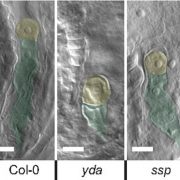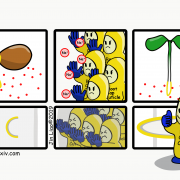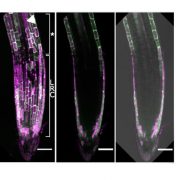Global topological order emerges through local mechanical control of cell divisions in the Arabidopsis shoot apical meristem (Cell Systems)
 In plants, the final shape of organs depends on how and when the cells divide. To get some insights about the rules governing this process, Jackson et al. applied network science to study the cell organization dynamics in the shoot apical meristem (SAM). They studied the L1, L2 and L3 cell layers in the SAM, where they tracked cell division over time. Cells in that tissue can be represented as a spatial network, in this case, nodes represent cells, and edges are the shared cell interfaces. Once the networks are generated, topological analysis can be performed as in other kinds of networks. The authors analyzed how local (i.e., node degree) and global (i.e., betweenness centrality) topological properties are related to cell division. The implications of mechanical interactions between cells were also studied using the katanin1 mutant, in which microtubule networks are disrupted, affecting mechanical interactions between cells. This work is helping to understand how cells organize in order to create complex tissues and organs. (Summary by Humberto Herrera-Umbaldo) Cell Systems 10.1016/j.cels.2018.12.009
In plants, the final shape of organs depends on how and when the cells divide. To get some insights about the rules governing this process, Jackson et al. applied network science to study the cell organization dynamics in the shoot apical meristem (SAM). They studied the L1, L2 and L3 cell layers in the SAM, where they tracked cell division over time. Cells in that tissue can be represented as a spatial network, in this case, nodes represent cells, and edges are the shared cell interfaces. Once the networks are generated, topological analysis can be performed as in other kinds of networks. The authors analyzed how local (i.e., node degree) and global (i.e., betweenness centrality) topological properties are related to cell division. The implications of mechanical interactions between cells were also studied using the katanin1 mutant, in which microtubule networks are disrupted, affecting mechanical interactions between cells. This work is helping to understand how cells organize in order to create complex tissues and organs. (Summary by Humberto Herrera-Umbaldo) Cell Systems 10.1016/j.cels.2018.12.009









